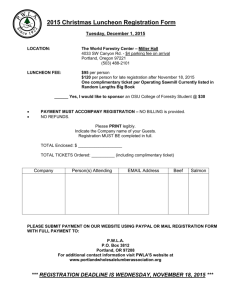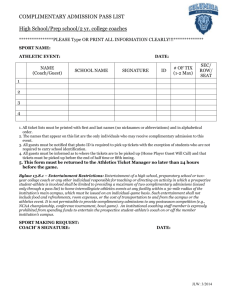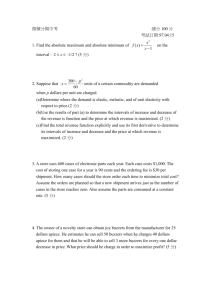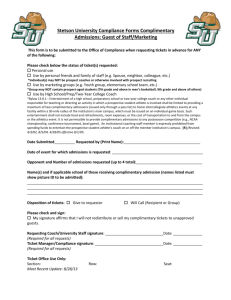Sport and Safety Management
advertisement
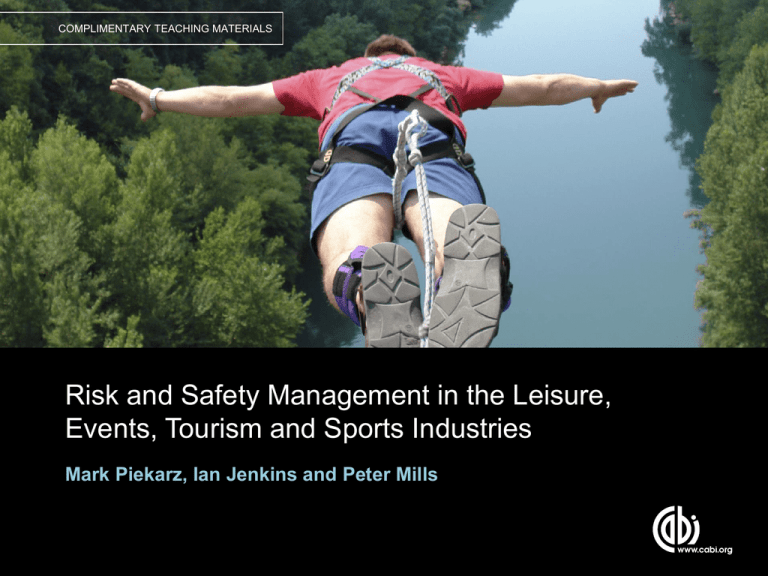
COMPLIMENTARY TEACHING MATERIALS Risk and Safety Management in the Leisure, Events, Tourism and Sports Industries Mark Piekarz, Ian Jenkins and Peter Mills Chapter 11 - Learning from the Past (Case Study Analysis) COMPLIMENTARY TEACHING MATERIALS LEARNING OBJECTIVES • Apply the key theoretical concepts to a range of case studies. • To show the value of researching and analysing past incidents to help identify hazards and risks. • Illustrate the benefits of case study analysis of past incidents to identify causation factors, which can then be used for future scenario writing. • To show the value of comparative analysis of cases between sectors, countries and levels of management. COMPLIMENTARY TEACHING MATERIALS INTRODUCTION • Case studies are a useful vehicle for understanding risk management. • Important to link theory and models to case study examples. • Case studies are specific and not always representative. • They need to be linked to other data and generalised analysis of risks and accidents. • Need to be aware of key concepts. COMPLIMENTARY TEACHING MATERIALS KEY CONCEPTS • • • • • Key risk benefits Anatomy of risks Key risk exposure dimension Trigger example Causation categories (agents or variables) COMPLIMENTARY TEACHING MATERIALS SPORT INJURIES AND VIOLENCE • Spinal injuries in sport and the case of Ben Smoldon • Kevin Everett (USA American football) spinal injury • The risk of concussion in soccer and American football • Coaching abuse in sports COMPLIMENTARY TEACHING MATERIALS ADVENTURE RELATED CASE STUDIES • Lyme Bay • Surf accidents (Australia) • Death during a tough mudding event (USA) • Adventure world company (Switzerland) COMPLIMENTARY TEACHING MATERIALS EVENT MANAGEMENT • Key case study – Hillsborough • Athlete security – Monica Seles stabbed • Serbia vs Albania football game cancelled • Terrorist attacks on Sport COMPLIMENTARY TEACHING MATERIALS TOURISM • Terrorist attacks on tourists • P&O ferry disaster • A volcanic eruption COMPLIMENTARY TEACHING MATERIALS CONCLUSION • Case studies consider a wide range of risk factors, not only to safety. • Hazards and risks relate to operational conditions, project management and strategic planning. • Important to read these cases remembering the stories and key factors of failures. • Proper control measures to deal with the risks. • Finally, need to develop the art of modelling future scenarios of what could happen, unless certain safety management actions are taken. COMPLIMENTARY TEACHING MATERIALS References BS 8848:2014 (2014) Specification for the provision of visits, fieldwork, expeditions and adventurous activities outside the United Kingdom, BS, UK. Carmody, D.J, Taylor, T.K., Parker, D.A., Coolican, M. R. and Cumming, R.G. (2005) Spinal cord injuries in Australian footballers 1997-2002, Medical Journal of Australia, 182 (11), 561-564. Darby, P. Johnes, M. & Mellor, D. (ed) (2005) Soccer and Disaster: International Perspectives, Routledge, London. Elliot, D., Frosdick, S. and Smith, D. (1997) The failure of ‘legislation by crisis’ in Frosdick, S. and Walley, L. Sport and Safety Management, Butterworth & Heinemann, London. Emery. P. (2010) Past, present, future major sport event management practice: The practioner perspective. Sport Management Review, 13, 158170. Frosdick, S. (1997) Managing risk in Public Assembly facilities, in Frosdick, S. and Walley, L. Sport and Safety Management, Butterworth & Heinemann. London. COMPLIMENTARY TEACHING MATERIALS Fuller, C. (2007) Catastrophic Injuries in Rugby Union: An Assessment of the Risk (Draft report), Report published for the RFU, available at: http://irbplayerwelfare.com/pdfs/CI_Risk_Assessment_EN.pdf, accessed 20 September 2014. Glaesser, D. (2003), Crisis management in the tourism industry, Butterworth & Heinemann, Oxford. Merna, T. and Faisal, F. A. (2005) Corporate risk management: an organizational perspective, John Wiley & Sons, Chichester. Rihn, J.A., Anderson, D.T., Lamb, K., Deluca, P.F., Bata, A., Marchetto, P.A., Neves, N. and Vaccaro, A.R. (2009) Cervical spine injuries in American football, Sports Medicine, 39 (9), 697-708. COMPLIMENTARY TEACHING MATERIALS Thank You Name: Email: Dr. Ian Jenkins & Dr. Mark Piekarz dr.isjenkins@gmail.com, m.piekarz@worc.ac.uk COMPLIMENTARY TEACHING MATERIALS
